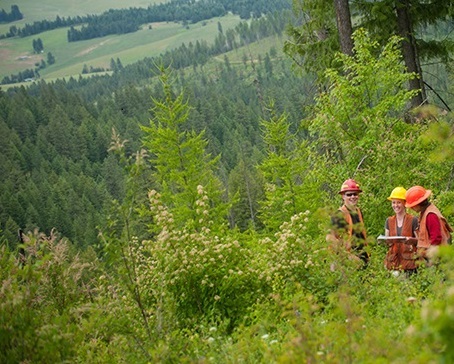 For more than 80 years, the University of Idaho Experimental Forest has provided a working forest classroom for students. The management units, natural areas, and outdoor classrooms provide the connection to field-based forestry education and faculty and graduate research. In 1932, the Forest Development Company (now Potlatch Corporation) of Lewiston, Idaho, made the first of several land donations that would eventually total over 6,500 acres. Other donations, exchanges, and purchases have brought the acreage to its present 7,300 acres.
For more than 80 years, the University of Idaho Experimental Forest has provided a working forest classroom for students. The management units, natural areas, and outdoor classrooms provide the connection to field-based forestry education and faculty and graduate research. In 1932, the Forest Development Company (now Potlatch Corporation) of Lewiston, Idaho, made the first of several land donations that would eventually total over 6,500 acres. Other donations, exchanges, and purchases have brought the acreage to its present 7,300 acres.
Potential climax communities are varied. The transition from true prairie to forest has a great influence on vegetation even within the forest's narrow elevation range of just 1,000 feet. Grand fir (Abies grandis) is the dominant tree species followed by Douglas-fir (Pseudotsuga menziesii), western hemlock (Thuja plicata), subalpine fir (A. lasiocarpa), and ponderosa pine (Pinus ponderosa).
Masticated fuels and fire behavior in forests of the Interior West - From the absract: The University of Idaho Experimental Forest will be one of the sites utilized to study fire behavior resulting from the combustion of masticated fuels (mechanical mulching). Researchers will characterize regional variation in masticated fuel beds from multiple machines and ages since treatment (1-4 yr) in lodgepole pine forests, dry ponderosa pine-dominated forests, moist mixed-conifer forests, and young mixed-conifer forest plantations. Laboratory experiments will be used to characterize fire intensity, spread, duration, and combustion phase under treatments of moisture content, particle size, fuel bed depth, and wind. Replicated experiments with prescribed fires in masticated fuels will be conducted to evaluate scaling up from lab and field experiments to operational treatments.
Fire Behavior / Smoke & Air Quality: The combustion of sound and rotten coarse woody debris: a review
Fire Effects - Fire Severity: The relationship of post-fire white ash cover to surface fuel consumption
Effects of slash pile burning on the physical and chemical soil properties of Vassar soils
Fire Effects - Plants: Germination and initial growth of four coniferous species on varied duff depths in northern Idaho
Fire Effects / Management Approaches: Livestock grazing influences on community structure, fire intensity, and fire frequency within the Douglas-fir/ninebark habitat type
Fuels Assessments & Monitoring: Characterizing and mapping forest fire fuels using ASTER imagery and gradient modeling
Biomass research on the University of Idaho Experimental Forest - video